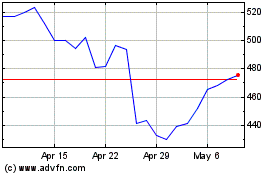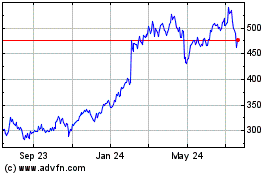Facebook to Give Friends' Posts More Weight
June 29 2016 - 10:40AM
Dow Jones News
Facebook Inc. shed new light on how it determines what its 1.65
billion users see each time they sign on, in its latest effort to
demystify its inner workings.
The social network also said it would prioritize posts from
friends and family in users' news feed over content from publishers
and public figures, in hopes of persuading users to spend more time
on the site.
The news feed changes could mean some publishers will see
readership on Facebook decline "a small amount but a noticeable
amount," said Adam Mosseri, the product manager who runs Facebook's
news feed. "Some publishers may go up, some publishers may go down,
some publishers may go down more."
The broader explanation about how the news feed works was
outlined in a two-page document the company posted on its website.
Its release comes amid growing scrutiny of Facebook, after a report
last month that contractors suppressed conservative viewpoints from
its trending topics feature. Facebook denied bias, but revealed
that humans were involved in the selection of headlines to a
greater extent than it previously disclosed.
The controversy also exposed broader confusion among users about
what appears in their news feeds. Facebook relies largely on an
algorithm, or computer program, that combs through roughly 100,000
signals and creates a "relevancy score" for each post for a
specific user. No two users have the same news feed.
On Wednesday, Facebook made clearer than it has in the past that
people also are involved in selecting and prioritizing items in the
news feed.
"It's important for people to understand that there's a group of
people who work on news feed, not just sort of like a third party
agent that acts autonomously," Mr. Mosseri said.
He said Facebook wants to show users posts that those users want
to see. "That is an opinion. That isn't neutral. That's not a
political bias, but that is a bias and that is reflected in our
decisions and therefore it is reflected in our ranking order," Mr.
Mosseri said.
Facebook tweaks the algorithm often—roughly once a month over
the last 2 ½ years. Many of the changes are aimed at making the
feed less promotional and repetitive. Facebook generally discloses
in broad terms when and how it has altered the formula.
Each change is tested in a small group of Facebook users. There
are 200 people on Facebook's news feed team, led by Mr.
Mosseri.
The latest tweak came after Facebook found that users felt posts
from friends were being "drowned out" by publishers, Mr. Mosseri
said. Facebook has become an important source of news for many
users, who spend an average of 50 minutes a day on the social
network, according to the company. As a result, publishers often
post hundreds of items a day. Friends, by contrast, post just a few
times a week, Mr. Mosseri said.
"The thing that we're worried about is people connecting to
their friends less than they want because" publishers post so
often, he said.
Posts from personal connections now trump those from public
figures and publishers, Facebook said. It also said it would favor
what it described as "authentic" posts, rather than spam or
misleading articles, colloquially known as clickbait. "People don't
like seeing clickbait, they complain about it, they report it. We
get bug reports," Mr. Mosseri said.
Posts widely shared by Facebook users will be less affected.
Once a user shares an article, video or other content, Facebook
considers it "friend content," Mr. Mosseri said. That means it will
appear higher in a user's news feed.
Write to Deepa Seetharaman at Deepa.Seetharaman@wsj.com
(END) Dow Jones Newswires
June 29, 2016 10:25 ET (14:25 GMT)
Copyright (c) 2016 Dow Jones & Company, Inc.
Meta Platforms (NASDAQ:META)
Historical Stock Chart
From Apr 2024 to May 2024

Meta Platforms (NASDAQ:META)
Historical Stock Chart
From May 2023 to May 2024
